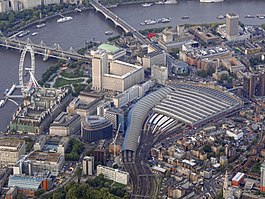
Back واترلو (محطة) Arabic Вакзал Ватэрлоа Byelorussian Ватэрлёо (вакзал) BE-X-OLD লন্ডন ওয়াটারলু স্টেশন Bengali/Bangla Estació de London Waterloo Catalan Waterloo (železniční stanice) Czech Gorsaf reilffordd Waterloo Llundain Welsh Waterloo Station Danish Bahnhof London Waterloo German Stacidomo Waterloo Esperanto
| Waterloo | |
|---|---|
| London Waterloo | |
 Aerial view from the south, showing Waterloo station, Waterloo, Hungerford Bridges and the London Eye | |
| Location | Lambeth |
| Local authority | London Borough of Lambeth |
| Managed by | Network Rail |
| Station code(s) | WAT |
| DfT category | A |
| Number of platforms | 24 |
| Accessible | Yes[1] |
| Fare zone | 1 |
| OSI | Waterloo Waterloo East Embankment Festival Pier London Eye Pier |
| Cycle parking | Yes – external opposite exit 3 |
| Toilet facilities | Yes |
| National Rail annual entry and exit | |
| 2019–20 | |
| – interchange | |
| 2020–21 | |
| – interchange | |
| 2021–22 | |
| – interchange | |
| 2022–23 | |
| – interchange | |
| 2023–24 | |
| – interchange | |
| Railway companies | |
| Original company | London and South Western Railway |
| Pre-grouping | London and South Western Railway |
| Post-grouping | Southern Railway |
| Key dates | |
| 11 July 1848[4] | Opened |
| 21 March 1922 | Rebuilt |
| 14 November 1994 – 13 November 2007 | Eurostar terminal |
| Other information | |
| External links | |
| Coordinates | 51°30′11″N 0°06′48″W / 51.5031°N 0.1132°W |
Waterloo station (/ˌwɔːtərˈluː/),[5][6] also known as London Waterloo, is a major London terminus on the National Rail network in the United Kingdom, in the Waterloo area of the London Borough of Lambeth. It is connected to a London Underground station of the same name and is adjacent to Waterloo East station on the South Eastern Main Line. The station is the terminus of the South West Main Line to Weymouth via Southampton, the West of England main line to Exeter via Salisbury, the Portsmouth Direct line to Portsmouth Harbour which connects with ferry services to the Isle of Wight, and several commuter services around west and south-west London, Surrey, Hampshire and Berkshire.
The station was opened in 1848 by the London and South Western Railway, and it replaced the earlier Nine Elms as it was closer to the West End. It was never designed to be a terminus, as the original intention was to continue the line towards the City of London, and consequently the station developed in a haphazard fashion, leading to difficulty finding the correct platform. The station was rebuilt in the early 20th century, opening in 1922, and included the Victory Arch over the main entrance, which commemorated World War I. Waterloo was the last London terminus to provide steam-powered services, which ended in 1967. The station was the London terminus for Eurostar international trains from 1994 until 2007, when they were transferred to St. Pancras.
Waterloo is the third busiest station in the UK, and was formerly the busiest railway station in the UK, handling 57.8 million passengers in the year to March 2023.[7] It is also the UK's largest station in terms of floor space and has the greatest number of platforms.
- ^ "London and South East" (PDF). National Rail. September 2006. Archived from the original (PDF) on 6 March 2009.
- ^ "Out of Station Interchanges" (XLSX). Transport for London. 16 June 2020. Retrieved 5 November 2020.
- ^ a b c d e f g h i j "Estimates of station usage". Rail statistics. Office of Rail Regulation. Please note: Some methodology may vary year on year.
- ^ Jackson 1984, p. 215.
- ^ "Definition of 'Waterloo'". www.collinsdictionary.com. Retrieved 29 May 2020.
- ^ "Definition of Waterloo noun from the Oxford Advanced Learner's Dictionary". www.oxfordlearnersdictionaries.com. Retrieved 29 May 2020.
- ^ "Estimates of station usage". Office of Rail and Road Data Portal. Archived from the original on 2 February 2024.
